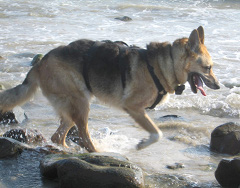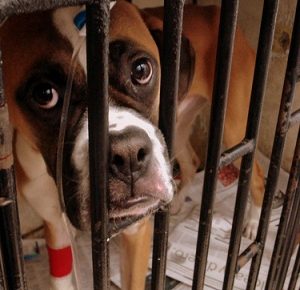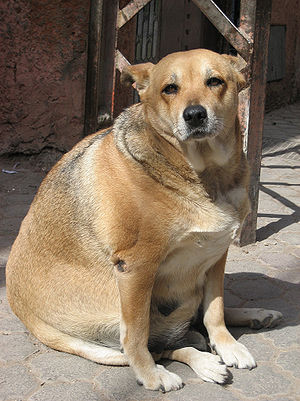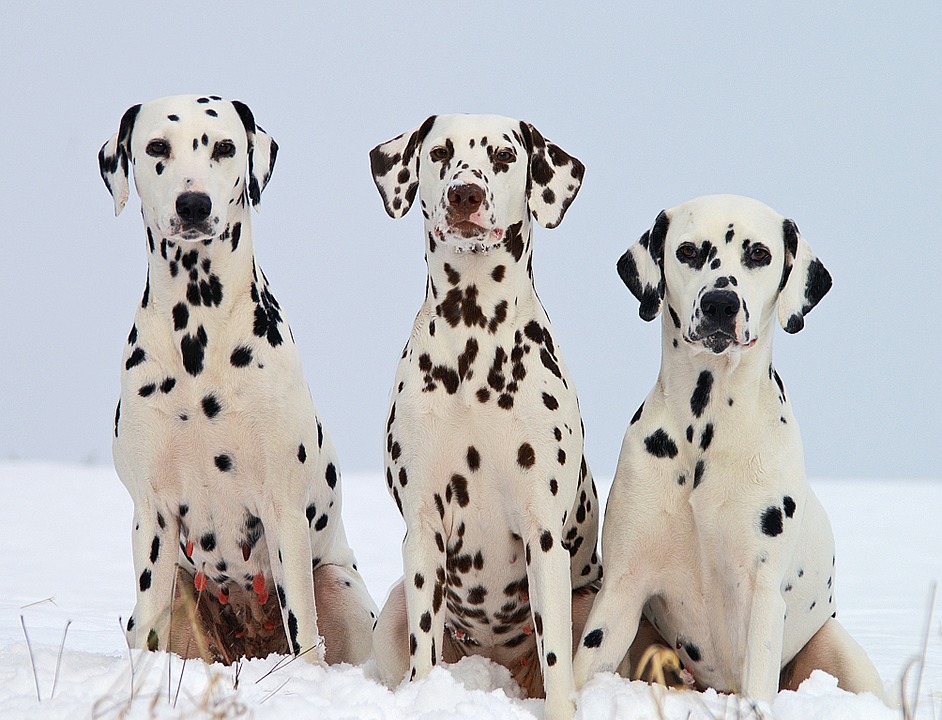Amputation is considered one of the oldest medical procedures, even for animals.
In ancient times dogs were not kept as pets, only as working animals. Depending on their jobs, tails and ears were docked, dewclaws removed and castration performed. Often these surgeries caused severe infection. If the dog could no longer perform its duties, it was destroyed. However limb amputation was rare.
Today in most places dogs are kept as cherished pets and we humans protect and care for them as respected family members.
The definition of amputation is the removal of a body part. An amputee is one who has had one or more limbs surgically removed.
Dogs can become amputees, Tripawds, for a number of reasons. Cancer, accidents, birth defects, gunshot wounds, bites, unhealed fractures, gangrene, degenerating bone diseases, abuse, to name a few.
Dogs who are allowed to run loose, their owners disobeying laws, are prime candidates for accidents leading to loss of a leg. Fortunately for these dogs, they adjust to be being tripawds very quickly and go on to live complete lives.
For amputees suffering from cancer, their lives are often extended and they are able to live pain-free with the hope that the disease will not spread.
Dogs that have life-threatening situations such as severe infections, frostbite, irreparable damage, undergo amputation to eliminate the problem.
Owners of amputees are generally very caring people who want to give their dogs the best chances for survival and have no biases towards the handicapped.
There are several things to consider before proceeding with amputation. The dog’s temperament can be a factor as well as age, weight and general physical condition. Another consideration would be if the owner is physically capable of caring for an amputee.
Since 60% of a dog’s weight is carried by the front legs, a dog with severe hip displasia might not be a candidate for amputation. Each dog has to be evaluated individually.

Having personal knowledge of a *Tripawd and being acquainted with many other tripawds, I believe I can safely say that dogs of any size and most ages learn to manage very well on three legs. They don’t miss the leg and go on with their normal lives.
Osteosarcoma, bone cancer, where amputation is the usual route, appears to be more prevalent in large breeds and seems to affect front legs more often than rear legs.
It wasn’t too long ago when we thought animals had no feelings or emotions. These days we are well aware of the wide range of emotions exhibited by our dogs.
In the wild dogs tried not to show pain as they would be abandoned by their pack or worse become prey. Often this stoicism continues into modern day life. That’s why it’s so important for your dog to have regular checkups. Early discovery of a problem can make a difference in how your dog responds to treatment.
Controlling pain is an important part of treatment of amputees before and after surgery. Signs of pain can be loss of appetite, limping, reduced activity, change in breathing, restlessness, trembling, behavioral changes, whining or whimpering.
There are several different classes of pain relievers. The include NSAIDs (non-steroidal anti-inflammatory drugs); corticosteroids (hormones); analgesics (opiates or narcotics and sedatives). As with all drugs there can be side effects and your dog should be closely monitored by you and your veterinarian.
There are also holistic and homeopathic remedies made from herbs, flower extracts and infusions. Reiki, massage, acupuncture and acupressure have also been used successfully to relieve pain. Keep your vet informed as to the course you wish to follow for your dog. Often regular vets, holistic vets and oncologists will work together to treat your dog.
Research the facility where your dog will undergo amputation. Make sure the surgeon is skilled, the staff is competent, proper equipment is available and the facilities are spotlessly clean. Do not allow the clinic to perform surgery unless 24 hour care is offered or arranged.
After surgery your dog will receive antibiotics to prevent infections and pain medication.
Don’t panic when you first see your dog. There will be areas where the fur has been shaved and there may be visible bruising. There can be swelling (seromas which are a buildup of fluids) or leaking at the surgical site. When your dog is ready to go home, your vet will instruct you whether to apply hot or cold compresses, supply you with any necessary medications or any other care. In some cases the fluid will have to be drained. Watch for any signs of discomfort. Don’t hesitate to call your vet anytime with any questions you may have.
When the incision site is healing your dog may want to lick or chew it. If so, ask your vet if it’s advisable to bandage the area. Some people dress their dogs in T-shirts that cover the site and prevent chewing. There are new collars that restrict the dog from reaching the site but are more comfortable to wear. If you have other pets, be sure they don’t show any interest in the surgery site or you may have to keep them separated until healing takes place.
Your dog may behave differently after amputation. Some depression or lethargy is not uncommon. If your dog is in pain, he may exhibit some aggression. Discuss with your vet any behavioral changes. Your dog may tire easily and sleep more. Keep in mind that each dog recovers at a different rate, some quickly while others may take a while longer. The extra rest and sleep will encourage the body to repair itself.
Since your dog will be placing more pressure on the other legs and back, keep a close watch for other injuries or soreness and attend to them immediately. Your vet will prescribe treatment, including pain relievers and rest.
You can prepare your home beforehand for the comfort of the amputee. You may want be have a comfy bed ready for the dog near you. Place non-skid rugs or mats on normally traveled bare floors. There is a product called UGlu strips for throw rugs. They keep the rugs in place, are inexpensive and easily replaced. If your dog has difficulty bending down to eat, raise the feeding dish. Many dogs have difficulty with steps. If you have an upstairs, temporarily use a gate so your dog won’t attempt to use them. You may want to limit the use of stairs anyway unless you are home to supervise to prevent accidents from occurring. There are different styles of harnesses and slings made that you can use to help your dog go out to walk and potty. Harnesses and slings are made for both front and hind leg amputees. I used a large bath towel as a sling, but after the first day my dog was able to manage on her own. You can purchase ramps for easier access to furniture, in and out of the house and your car. There are also doggie boots that have non-slip surfaces (if your dog is comfortable wearing them). Wintertime and deep snow present another problem for the amputee. Keep an area cleared for your dog to relieve itself.
The important thing is to make your dog as comfortable, safe and secure as possible. As your dog heals, he will learn to balance and will become a more confident tripawd.
Never allow your tripawd outdoors alone unless you have a fenced-in yard. Your dog will be at a disadvantage if he must defend himself. Your dog may have become a tripawd because he was allowed to be out on his own.
Tripawds with cancer who are undergoing chemotherapy or radiation may experience other complications like vomiting or nausea, some hair loss, although these reactions are not as severe as with humans. Again, ask your vet how you can make your dog more comfortable. Often, your vet will prescribe an antacid to administer beforehand to avoid an upset stomach.
Most amputees, once they have healed, will be able to do nearly everything that a four-legger can do. However, pawrents should monitor play and exercise sessions carefully to avoid joint stress and over exertion. Tripawds have less endurance than four leggers, and although they’ll try to keep up, it’s up to their humans to ensure they don’t overdo it.
Exercises that develop core muscle strength and proprioception are vital to maintain optimal fitness for all dogs, but especially for canine amputees. The best exercises to do with your Tripawd include unstable surface work and weight bearing activities. These fitness games help with core strengthening, increased range of motion and flexibility, sensory and perceptual stimulation, joint alignment, and balance control. Remember, walking is great for endurance, but it does not build strength. Always ensure your Tripawd is taking plenty of breaks during exercise. If your Tripawd sits down, he’s overdone it. Try not to let that happen.
Keeping your Tripawd thinner than dogs of his size/breed is critical. Overweight Tripawds do not do well.
Living with a Tripawd is a lesson to humans that we are more than the sum of our parts. These canine heroes are an inspiration to be around, and can teach humans endless lessons about perseverance, resilience making the most of a tough situation. One Tripawd can change your life forever.
Related Articles:
- Log of Timo’s Fight with Cancer
- Tripawds 3-Legged Dog Blogs and Discussion Forums
- Canine Amputation Handbook
- Answers to Common Tripawds Questions
- Living with a Lame Pet
Note: The word “Tripawd(s)” and “It’s Better to hop on 3 than to limp on 4” are registered trademarks of Agreda Communications.



